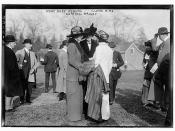This study deals with gender inequality in the modern society and looks at the difficulties women face when they strive for equal success as their male counterparts. About seventy-five percent of the jobs in well-paid professions are held by men and even if women are able to get equal jobs they are still paid considerably less . The central question posed is, are there any differences in the aspirations and career goals between males and females? However, in order to fully understand stereotypical social values about sex-roles in our society, an analysis of the broader context, in terms of the findings of the research of experts in the field, is needed. Thus, this Literature Review discusses the research on gender discrimination in the modern society as well as what drives women into the workforce.
Joanne Naiman, Professor of Sociology at Ryerson Polytechnic University, who has written extensively on how the gender roles change in Canadian society, argues that "historically sociologists have suggested, amongst various other reasons that biological differences between men and women constitute as one of the main reasons for males having better job opportunities.
Thus males were always branded the breadwinners of the family whilst a female's place was at home" . Studies by Joanne Naiman have shown that "during the latter half of the 20th century these views began to slowly change but still stained with the ideologies from the past they still exist at the brink of the 21st century" . Lawrence Pervin, Professor of Psychology at the Princeton University contends that "up until 1954 researchers tended to ignore female workers as subjects of their research. From 1954 to 1966 sex-role measures developed. From 1974 to 1982 androgyny was established as sex-role ideal" . Another psychologist and prolific writer, Carol Gilligan stated that "as far...
![[Mary, Queen of Scots] (LOC)](https://s.writework.com/uploads/9/91750/mary-queen-scots-loc-thumb.jpg)

